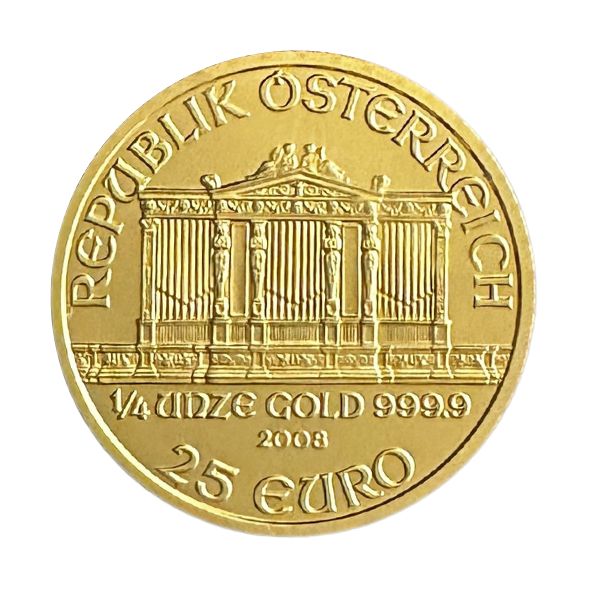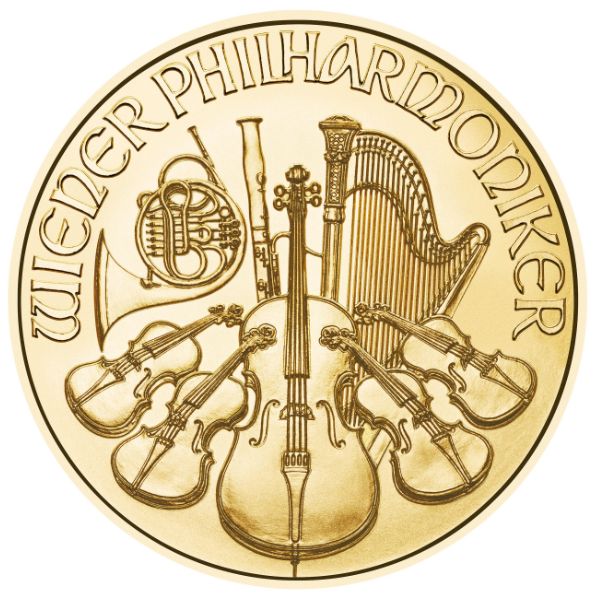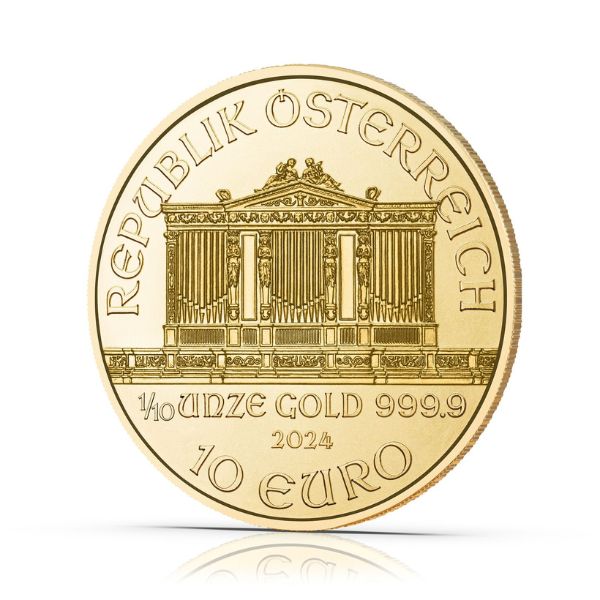Are Austrian Gold Philharmonics a Good Investment?

At a Glance:
-
- Austrian Gold Philharmonics feature beautiful artwork celebrating Vienna’s musical history.
- The coin is minted with .9999 fine gold and available in multiple weights.
- Gold Philharmonics can be a great way for investors to diversify their gold portfolios.
Austrian Gold Philharmonics: Are They a Good Investment?
Investors looking for something new to add to their gold stack should take a closer look at the Austrian Gold Philharmonic. The coin’s high gold purity, weight variety, and exceptionally unique designs make it an underrated collectible with unparalleled investment potential.
Most investors are familiar with the popular coins that dominate the market. Coins like the Gold Eagle, Gold Britannia, and Gold Maple Leaf are undeniable classics. Each year, hundreds of thousands of these coins flood the market. There’s a reason why the world’s most popular gold coins appeal to so many investors.
There’s another popular coin, though, that flies under the radar of gold bullion enthusiasts every year. The subject of today’s Bullion Academy post is the Austrian Gold Philharmonic. Also known as the Vienna Philharmonic, the coin has been a staple of many gold collections since its initial release in 1989.
On this page, you’ll find everything you need to know about the history, specifications, and investment potential of the Austrian Gold Philharmonic Coin.
History: The Austrian Gold Philharmonic
Like many of the world’s most popular coins, Austria’s Gold Philharmonic made its debut in the late 1980s. Governments all over the planet scrambled to release their own gold coins to take advantage of the market gap left after major governments banned the import of Gold Krugerrands. With the favorite coin of so many investors out of commission, governments everywhere competed to fill the vacuum left behind by South Africa’s national gold coin.
Austria’s contribution to this competition was the Austrian Gold Philharmonic. The Philharmonic was first minted in 1989 – and it became an instant success. When they designed the coin, the Austrian Mint wanted to create a bullion investment that reminded collectors of everything there is to love about Vienna. They certainly succeeded; the unique designs featured on the Austrian Gold Philharmonic have helped to make it one of the most popular gold coins in Europe.
The Historic Austrian Mint
The Austrian Gold Philharmonic’s debut actually coincides with the founding of the modern Austrian Mint. The true beginnings of the Austrian Mint date all the way back to 1194. That year, Richard the Lionheart paid 15 tons of silver to Duke Leopold V in exchange for his release from prison. Leopold V established a mint to strike silver coins out of the bounty, although the formal Vienna Mint wasn’t codified until centuries later.
It wasn’t until 1989 that the Austrian Mint as we know it today was established as a public limited company. That same year, the Austrian government asked the mint to produce a new gold coin to commemorate the country’s history and culture. Since then, the Austrian Gold Philharmonic has been the most important yearly release to come out of the historic Austrian Mint.
Gold Philharmonic Details and Specifications
The Austrian Gold Philharmonic is among the purest gold coins in the world. Minted at a standardized fineness of .9999 (99.99%) pure gold bullion, the coin is as pure as the Gold Maple Leaf and the Gold Britannia. In fact, the Gold Philharmonic is even more pure than the American Gold Eagle.
Below, we’ll take a closer look at the Austrian Gold Philharmonic’s details, designs, and specifications.
Purity and Weight Variety
Austrian Gold Philharmonics clock in at a fineness of .9999, or 99.99% pure gold bullion. Generally, this is as pure as a gold coin can get. Certain coins are minted with 99.999% fine gold, but this is rare. Like the Canadian Gold Maple Leaf and the British Gold Britannia, Austrian Gold Philharmonics are almost entirely made of genuine gold bullion.
One advantage to investing in Austrian Gold Philharmonics is the coin’s weight variety. In addition to the full 1 oz coin, the Austrian Mint also produces a number of fractional denominations. Since 1994, Austrian Gold Philharmonics have been available in 1/10, 1/4/, ½, and full 1 oz weights.

Interestingly enough, the Gold Philharmonic has also been released in 1/25 oz weights since 2014. This makes the coin one of the few national gold coins we’ve seen that is available in such a low weight. The Gold Philharmonic is a fantastic option for investors working on a small budget.
Obverse Artwork
To most investors, the best part of the Gold Philharmonic is its designs. On the obverse, stackers will find the Musikverein pipe organ. This gigantic instrument is found in the Vienna music hall of the same name, and it’s become a world-renowned attraction for fans of music and culture.
The organ is rendered in exceptional detail. Music enthusiasts will note that each part of the instrument is clearly visible against the beautiful golden backdrop of the Austrian Gold Philharmonic. The obverse of the Gold Philharmonic also features the nation’s name, as well as the coin’s purity, year, and face value.
Reverse Artwork
Austrian Mint experts wanted to create a coin that represented the very best of Vienna’s culture. The reverse of the Austrian Gold Philharmonic pays homage to Austria’s musical history. On the backside of the coin, investors will find eight orchestra instruments. These instruments include the Vienna horn, four violins, a cello, a bassoon, and a harp.
The uniqueness of the Austrian Gold Philharmonic is one reason why so many investors love the coin. Rather than celebrating a leader or a historic military victory, this gold bullion coin places its focus on the people and the culture that made Vienna famous.
Remember: Vienna is both the cultural capital of Austria and one of the musical world’s most historical cities. The concert halls and venues of Vienna played host to Mozart, Beethoven, Schubert, and dozens of other musicians whose impact on the history of music is undeniable.
Struck against .9999 fine gold bullion, the Austrian Gold Philharmonic’s design is a celebration of one of the world’s most recognizable musical cities.
Pros and Cons to Investing in Austrian Gold Philharmonics
Like any other gold coins, there are both pros and cons to investing in Austrian Gold Philharmonics. While the coin offers beautiful and culturally important designs, high gold purity, and impressive weight variety, it’s also not as recognizable as other popular coins and features minimal security features.

Below, readers will find some of the biggest advantages – and disadvantages – to putting their money into one of the world’s most beautiful gold bullion coins.
Pros to Buying Austrian Gold Philharmonics
Beautiful and cultural designs, a high gold fineness, and exceptional weight variety are the three main advantages to investing in Austrian Gold Philharmonics. Together, these benefits help explain why the Gold Philharmonic remains one of the world’s most popular gold coins for investors.
Beautiful and Cultural Designs
It’s hard to find any coin with designs as culturally relevant as the Gold Philharmonic. On the obverse of Austria’s most famous coin, you’ll find the Musikverein pipe organ. Located in the heart of Vienna at the Musikverein concert hall, this large pipe organ is an international destination for fans of music and culture.
An exceptional level of detail and intricacy help the Gold Philharmonics design to stand out among its peers. Each small part of the massive Musikverein pipe organ is clearly visible on the obverse of the Gold Philharmonic. For fans of music or culture, this coin’s designs are really without peer.
The reverse of the Austrian Gold Philharmonic is also very unique. Rather than a national seal or the face of a monarch, this coin takes yet another opportunity to celebrate Vienna’s unmatched musical reputation. Eight orchestra instruments rest on the reverse of this coin, giving it a unique look and feel that investors won’t find on any other coin.
High Gold Purity
There are coins purer than the Austrian Gold Philharmonic, but they’re exceptionally rare. For the most part, the coin’s 99.99% gold fineness is as pure as it gets for bullion coins. Higher purity coins do come with drawbacks. Namely, .9999 fine gold coins don’t have quite the durability we find on coins with .9167 fineness, such as the American Gold Eagle.
Still, investors interested in high purity gold can’t go wrong with the .9999 pure Austrian Gold Philharmonic.
Weight Variety
The Gold Philharmonic also offers one of the most impressive catalogs of fractional variations that we’ve been able to find. The standard 1 oz Gold Philharmonic is a consistent best-seller, but the coin is also available in 1/25 oz, 1/10 oz, ¼ oz, and ½ oz weights.
1/25 oz coins are hard to come by, but they can be great for investors who want to start stacking gold but don’t have $2,000+ to spend on a brand new full 1 oz gold coin. Even seasoned gold stackers might consider adding 1/25 oz gold coins to their collection. Smaller coins come with higher premiums over spot price, but they also build some liquidity into a portfolio.

Being able to buy and sell Gold Philharmonics without having to liquidate full ounces of gold bullion helps to make the Austrian Gold Philharmonic one of the world’s best coins for new investors.
Cons to Investing in the Austrian Gold Philharmonic
Two main cons to investing in Austrian Gold Philharmonics: low recognizability compared to other gold coins and minimal security features. Smart stackers can still put their money into Gold Philharmonics – but they should be aware of a couple limitations the coin has.
Low Recognizability Compared to Other Coins
Since its debut in 1989, the Austrian Gold Philharmonic series has been one of the world’s most popular gold bullion coins. From 1989 to 2012, the coin sold 14 million units, which is the equivalent of around 329 tons of pure gold bullion.
Despite its popularity, the Gold Philharmonic might not be quite as recognizable as some of the other record-smashing gold coins on the market. In particular, the coin fails to have the instant recognizability of the Gold Eagle or Canadian Gold Maple Leaf. This could be a problem for investors who plan to sell their coins later down the line.
Coins like the Gold Eagle feature very tight buy-sell spreads because their demand is constantly high. Everyone knows what the Gold Eagle looks like, so it’s never a chore to find a buyer willing to pay top-dollar for one.
It’s worth noting that the Austrian Gold Philharmonic is still very easy to recognize among gold collectors. The coin’s mintage figures have also climbed in recent years. From 2019 to 2020, production numbers for the 1/25 oz Austrian Gold Philharmonic nearly tripled, going from just over 44,023 to 119,230. Other denominations also saw a rise in demand.
The Austrian Gold Philharmonic might not be quite as recognizable as the Gold Eagle, but it’s still an easy-to-liquidate coin that should find a place in most solid gold portfolios.
Minimal Security Features
While Vienna’s mint is world-renowned for its artistry and coin designs, the mint still lags behind a bit when it comes to security. The coin features a missing reed for added security against counterfeits. But when we compare the Gold Philharmonic to the security features of the Gold Britannia, it doesn’t quite stack up.
The good news: the Gold Philharmonic isn’t the most counterfeited gold coin. That distinction goes to the American Gold Eagle. Gold Philharmonics don’t have the sophisticated security features pioneered by the British and Canadian Royal Mints, but it’s still a stunning, intricately detailed gold bullion coin.
Fun Fact: The Saga of “Big Phil”
“Big Phil” is the nickname given to the largest Austrian Gold Philharmonic ever produced. Weighing in at a jaw-dropping 1,000 troy ounces, it retained the title of the world’s biggest gold coin until 2007, when it was beaten by the 100 kg Canadian Gold Maple Leaf.
Big Phil was minted to celebrate the 15th anniversary of the series. Several of this large coin were minted, and one is currently on display at the Austrian Mint’s headquarters.
Are Austrian Gold Philharmonics a Good Investment?
Although it is one of the world’s best-selling coins, some investors might not know much about the Austrian Gold Philharmonic. Featuring a high gold purity, fractional denominations, and some of the most unique sets of artwork in the industry, the Austrian Gold Philharmonic is a fantastic choice for investors looking to expand their portfolio with genuine gold bullion.
You might also be interested in:
About The Author
Michael Roets
Michael Roets is a writer and journalist for Hero Bullion. His work explores precious metals news, guides, and commentary.
